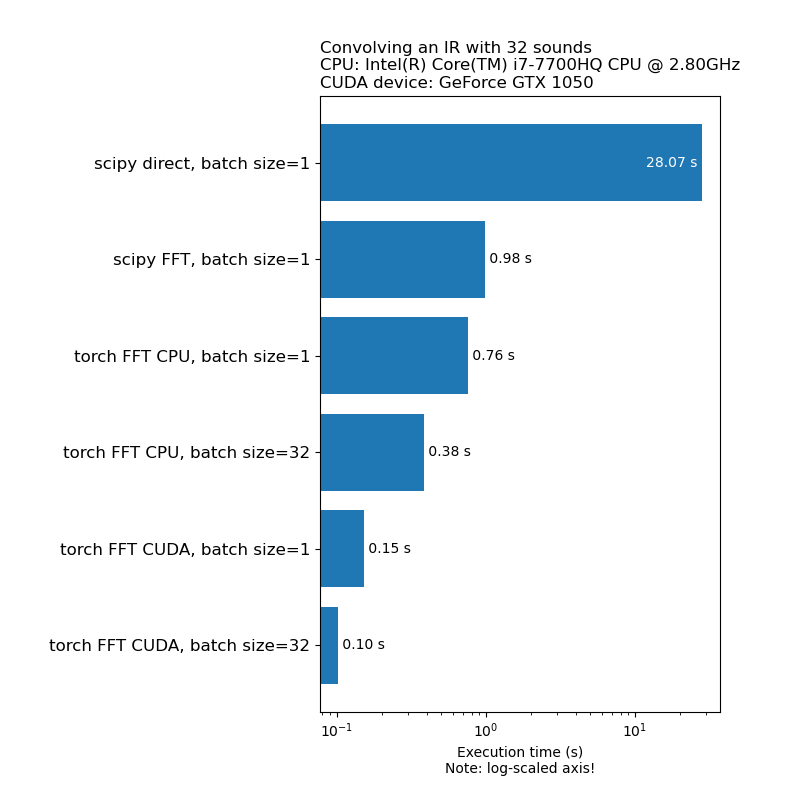Audio data augmentation in PyTorch. Inspired by audiomentations.
- Supports CPU and GPU - speed is a priority
- Supports batches of multichannel (or mono) audio
- Transforms extend
nn.Module, so they can be integrated as a part of a pytorch neural network model - Most transforms are differentiable
- Three modes:
per_batch,per_exampleandper_channel - Cross-platform compatibility
- Permissive MIT license
- High test coverage
pip install torch-audiomentations
import torch
from torch_audiomentations import Compose, Gain, PolarityInversion
# Initialize augmentation callable
apply_augmentation = Compose(
transforms=[
Gain(
min_gain_in_db=-15.0,
max_gain_in_db=5.0,
p=0.5,
),
PolarityInversion(p=0.5)
]
)
torch_device = torch.device("cuda" if torch.cuda.is_available() else "cpu")
# Make an example tensor with white noise.
# This tensor represents 8 audio snippets with 2 channels (stereo) and 2 s of 16 kHz audio.
audio_samples = torch.rand(size=(8, 2, 32000), dtype=torch.float32, device=torch_device) - 0.5
# Apply augmentation. This varies the gain and polarity of (some of)
# the audio snippets in the batch independently.
perturbed_audio_samples = apply_augmentation(audio_samples, sample_rate=16000)Contributors welcome!
Join the Asteroid's slack
to start discussing about torch-audiomentations with us.
We don't want data augmentation to be a bottle neck in model training speed. Here is a comparison of the time it takes to run 1D convolution:
torch-audiomentations is in an early development stage, so the APIs are subject to change.
Not released yet
Add background noise to the input audio.
Added in v0.1.0
Multiply the audio by a random amplitude factor to reduce or increase the volume. This technique can help a model become somewhat invariant to the overall gain of the input audio.
Warning: This transform can return samples outside the [-1, 1] range, which may lead to clipping or wrap distortion, depending on what you do with the audio in a later stage. See also https://en.wikipedia.org/wiki/Clipping_(audio)#Digital_clipping
Not released yet
Convolve the given audio with impulse responses.
Added in v0.2.0
Apply a constant amount of gain, so that highest signal level present in each audio snippet in the batch becomes 0 dBFS, i.e. the loudest level allowed if all samples must be between -1 and 1.
This transform has an alternative mode (apply_to="only_too_loud_sounds") where it only applies to audio snippets that have extreme values outside the [-1, 1] range. This is useful for avoiding digital clipping in audio that is too loud, while leaving other audio untouched.
Added in v0.1.0
Flip the audio samples upside-down, reversing their polarity. In other words, multiply the waveform by -1, so negative values become positive, and vice versa. The result will sound the same compared to the original when played back in isolation. However, when mixed with other audio sources, the result may be different. This waveform inversion technique is sometimes used for audio cancellation or obtaining the difference between two waveforms. However, in the context of audio data augmentation, this transform can be useful when training phase-aware machine learning models.
To be addded in v0.5.0
Shift the audio forwards or backwards, with or without rollover
- Implement
Shift - Make
sample_rateoptional. Allow specifyingsample_ratein__init__instead offorward
- Implement
Composefor applying multiple transforms - Implement utility functions
from_dictandfrom_yamlfor loading data augmentation configurations from dict, json or yaml - Officially support differentiability in most transforms
- Transforms now return the input unchanged when they are in eval mode
- Add support for alternative modes
per_batchandper_channel
- Simplify API for using CUDA tensors. The device is now inferred from the input tensor.
- Implement
PeakNormalization - Expose
convolvein the API
- Initial release with
GainandPolarityInversion
A GPU-enabled development environment for torch-audiomentations can be created with conda:
conda create --name torch-audiomentations python=3.7.3conda activate torch-audiomentationsconda install pytorch cudatoolkit=10.1 -c pytorchconda env update
pytest
- Format python code with black
- Use Google-style docstrings
- Use explicit relative imports, not absolute imports
The development of torch-audiomentations is kindly backed by Nomono







